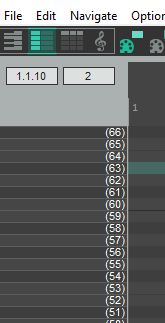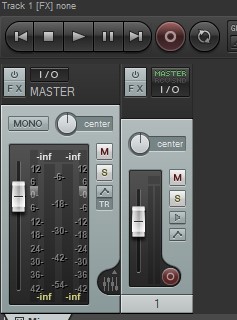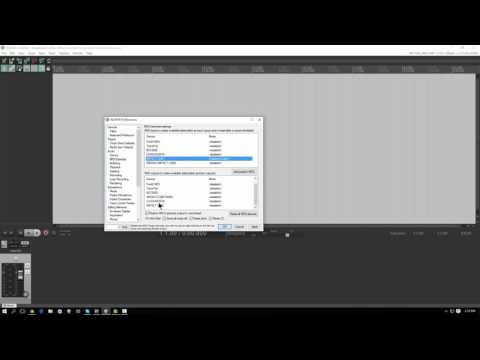Yeah, maybe you are right… as a fledgling bass player, I would always go for “bass-centric”… but perhaps that doesn’t always serve the music best!? Something for me to work on!
I would!
I found a really well made beginner Reaper tutorial, done by a young man who speaks clearly and slowly, and articulates very well. He starts out with the very basics of installing, etc. So you might want to skip through the first 10 minutes if you’re already familiar with that stuff.
He’s in an elaborate studio and uses a $400 DAI, but this is really aimed at non-professionals as well as professionals.
OMG is that a 7 string bass he’s playing?
He’s got some other Reaper videos out there as well. I really like this guy, very down to earth and quite knowledgeable.
@Howard or @terb or @eric.kiser or anybody; can you help me here. I followed your instructions to the letter and don’t see any way to control the drum machine (SR-16) from within Reaper. In fact, the MIDI cable doesn’t seem to play any role at all. I can record the drum machine in Reaper with or without the MIDI cable connected.

sorry Pam , I can’t help at all : I never use MIDI, I just feel it’s too complicated and I always prefer an analog way to do my things !
(and in fact that’s a problem for me, because the only way to save the settings on the Bass POD Pro is by MIDI, as this old thing is from the pre-USB era …)
I just downloaded the Reaper User Guide. I’m going to read it cover to cover… all 438 pages. 
Sound is not transmitted over the MIDI cable. Control information is. You use the MIDI out from Reaper to the drum machine to allow you to program drum patterns in Reaper’s nice MIDI sequencer. The reason you want to do this is the MIDI sequencer is a nice interface that makes sense. Drum machine pattern editors on the drum machine, in the other hand, are almost invariably garbage and are difficult to sync with your song in the DAW.
So, you just use the DAW to control everything.
The general rule of thumb for connecting electronic music instruments (like drum machines, synths, and computers) together is you want one of them to be the master that controls the timing and sync of all the others. And if you have a MIDI sequencer, like in Reaper, you want it to control everything.
So you are running a MIDI cable to the drum machine MIDI IN so that you can control it from the DAW.
This is going to require a bit of learning.
Yes, I have the MIDI cable running from the U-44 MIDI out to the SR-16 MIDI in. But I don’t see anywhere in Reaper where I can control the SR-16. That’s where I’m confused.
This is the part where you need to understand how MIDI works - and it’s complicated.
MIDI maps control information like notes to play to note numbers. These are sent over different channels to decide which instrument to go to.
Reaper has a few different MIDI sequencer views it comes with.
So what you do is add a MIDI track in Reaper and configure it to send on a specific channel (like, say, channel 10). And you configure your drum machine to listen on MIDI channel 10.
Then in the sequencer, you select which notes to send to the drum machine on which specific beats. This interface looks kind of like an old-time player piano roll.
This part initially kind of sucks because Reaper initially doesn’t know anything about your drum machine, so it doesn’t know which MIDI note makes what sound on the drum machine. The drum machine should have some docs about this (it’s MIDI mapping.) So then you have to edit the note names in the track editor to correspond to the samples. You can then save that as a MIDI mapping.
Once you do this you can then have a nice, logical interface for programming the drum patterns in Reaper. The steps are the same for most DAWs.
I’m “at” work now so I don’t have a lot of time, but I’ll try and find some videos later that describe this process, it’s complicated but you end up with a nice way to program drums. This is a similar process:
except instead of sending to ReaSampleMatic5000, you would send to the MIDI channel your drum machine is on.
Another option is to use the drum machine as the time source and do the programming on the drum machine. I prefer using the DAW to control things instead.
Thanks @howard. You’re awesome!
For now, you can just ignore MIDI and use the drum machine as an instrument. It will record its audio to a normal track just fine.
That’s what I’ve been doing
Ok. To use MIDI, the first thing you need to do is make sure your MIDI interface (in this case, the one in the U-44) is enabled in Reaper as both an output and input. The first half of this video describes that:
The second half uses the MIDI Keyboard he sets up; you can ignore that for now (but it is super useful if you want to add a MIDI keyboard to play a virtual instrument in Reaper.) But in general he is setting up a MIDI keyboard, whereas you are just enabling your MIDI interface.
Next, you need to get a good understanding of MIDI, how it is used, and how to use it in Reaper. This is complicated. There’s lots of videos on this, but they are generally focused on controlling virtual instruments, not external drum machines. Still, here’s one to get started, just remember that where they are controlling software instruments, we are going to control an external hardware one.
Next, you need to configure your drum machine to recieve MIDI. This will be described in its manual. Set it to receive MIDI on channel 10.
The next thing we need to do is make it relatively easy to use the sounds on your Alesis from within Reaper. First, download this file from Reaper Stash (which, btw, has a lot of cool stuff on it):
https://stash.reaper.fm/v/33010/Alesis%20SR-16%20Drum%20Map.txt
This is a MIDI mapping for the SR-16. Save it somewhere you can find later.
Brief aside, it turns out the SR-16 is so old-school it has a nonstandard MIDI implementation. For most MIDI instruments, that map would contain ways to get to every sound in the device. Instead, Alesis just symbolically mapped the device pads and it plays whatever drum kit you currently have selected on the Alesis. Don’t worry about that now, I just mention it because it is odd.
Anyway, now do this:
Open a new Reaper project.
Insert new track
Insert menu → New MIDI Item
Look at the new track at the bottom in the mixer, you should see a button called “Route”

Click Route and send MIDI output to the U-44 on channel 10.
Double click the new MIDI item. This opens the MIDI step editor. You will probably see a piano keyboard on the left; we want to see the MIDI event names instead. Tap the event list icon and basically make it look like this:

Now we’re going to load the MIDI map file we downloaded before. File menu → Note/CC names → Load Note/CC names from file → select the file you saved. This will load the mapping of midi notes in the editor to what’s on your drum machine. Mine looks like this:
The menu in the bottom right of this window may say “All channels” - that’s ok but ideally, make it say “channel 10”.
Ok! Now you should be able to click on any of those note names and have it play the corresponding sound on your drum machine, controlled from Reaper.
Basically we just did this, this is a good video explaining it.
Finally, you should be able to enter notes using the MIDI track editor and have them play on your drum machine. Here’s a video that shows how to do that, but don’t add a new instrument like he does, just use the track we just created to send on channel 10.
There’s a lot of good videos about using the MIDI editor. For example,
it’s a complex and powerful piece of software, with as lot to learn. But it ends up to be easy to use to write complex drum patterns easily, without having to do so in a much more tedious way on the drum machine.
One you have your MIDI pattern done, you can now create a separate audio track to capture the audio of your drum machine, and record; the MIDI notes will be sent to the drum machine, played, and recorded into the audio track.
There is A LOT to learn here. I have a few years of MIDI sequencing experience so I apologize if I glossed over anything or didn’t explain clearly.
If you do not want to do any of this, you also don’t have to. You can use and record your drum machine as a nice standalone instrument. I do this all the time too for simple patterns, they are very good for that. I do things this way because I find it much easier than programming on drum machines themselves, especially when laying out an entire song.
You can also use MIDI to the drum machine to ONLY control things like its tempo and so on; there’s tons you can do.
Bear in mind that he’s talking about both inputs and outputs in these, and usually virtual instruments in Reaper. You’re controlling a real (not virtual) external instrument.
You’ll probably run in to snags while doing this - that’s ok, everyone does. I ncourage you to mess around and try and get things to work! You’ll learn a lot.
Wow @howard, thank you for taking the time to compose such a lengthy and comprehensive explanation. I will devote some time to this. Again, you are awesome. Next time I’m in Japan I’ll buy you a Sapporo or two 
My pleasure! This is hard until you wrap your head around it. But in the end it lets you just draw your drum beats with a mouse.
The step editor concept has a long history and is actually how you do it in hardware on most drum machines. It’s just that most have a terrible UI for it, or have a great UI but only spanning one measure (backed by a terrible song builder UI). It’s something that in my experience is much, much better done in the music software, and Reaper has very good support.
This is actually much less complicated when using virtual instruments because you don’t have to deal with the external midi configuration or mapping. But it works more or less the same way for them too.
Holy shit! That was a pretty intense introduction @howard. Thanks.
@howard maybe I have a different version of Reaper. Mine doesn’t have thaat route button. Could it be somewhere else?

Nope. I can see the meter in the mixer jumping, but no sound coming out of the system. Even if I record a bunch of hits on the drums and symbols, nothing records.






